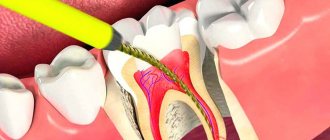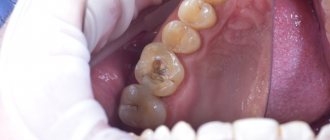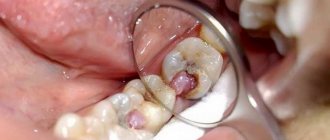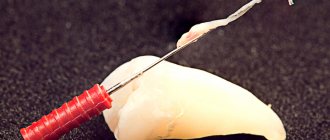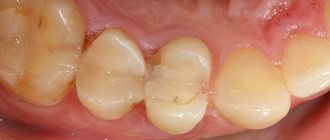Specialists in modern dentistry sometimes carry out such a procedure as replacing a filling. The reasons may be different, for example: a long-established filling (from amalgam, old mixed materials and cements) that needs updating. There are also more serious motives.
The filling serves to restore the original shape of the tooth, use it in the chewing process, and also to prevent its further destruction.
Over time, darkening appears in place of old fillings, indicating the presence of small cracks and further development of caries. At this point, replacing the filling is the best option (despite the fact that the filling may still hold well for some time).
In order to place a new filling, you must first remove the old filling.
The filling is made from different materials, so removal is individual for each option.
Pastes
Almost all types of pastes can be easily removed using a regular solvent. First, using Girdwood burs and long round burs, and then Hedström files or new reamers, the filling is removed. If removal occurs from the canals, then it is necessary to know exactly the length of the tooth, which is done using x-rays. It is also necessary to irrigate the canal frequently to remove any sawdust that appears.
After the filling is removed, it must be replaced with a new one. The most common of them are a light (light-polymer) filling, which is most often installed on the front part of the teeth, a cement filling (zinc phosphate, glass ionomer, zinc eugenol), as well as an inlay.
How long does a filling last?
The minimum service life of a filling is considered to be 3-5 years. Some materials last longer, up to 10 years. Much depends on the condition of the treated tooth after the minimum period.
What affects the service life of the filling:
- how correctly the dentist selected the size and installed the filling;
- the material from which it is made;
- what is the thickness of the walls of the abutment tooth and what condition is it in;
- what hygienic care is required: abrasiveness of pastes, hardness of the brush, use of special products;
- whether the patient has bad habits that have a harmful effect on the filling material;
- how much solid or tough food is in the diet, whether the temperature of food and drinks is moderate, etc.
Sealing
High-quality tooth filling occurs in 40-60 minutes. Root canals are washed using antiseptic agents and filled with sealed material. If the canals have been sealed professionally, then future infection is excluded.
The next step is filling the tooth cavity. The dentist installs the required matrix on it, suitable for the further shape. Then an adhesive (good adhesive) composition is applied and work is done on the future filling. The filling is laid in layers. The final stage involves adjusting the filling to the bite and polishing it.
In order to avoid replacing fillings, you need to carefully monitor your dental hygiene and visit the dentist as often as possible.
When to refill
The following conditions indicate the need to replace the filling:
- Pain in a filled tooth.
- Crown destruction.
- The appearance of caries on a tooth.
- Constant unpleasant taste in the mouth.
- Deterioration of restoration aesthetics.
- The seal has expired.
If you notice such signs, you should contact your dentist so that during an examination, a specialist can determine the cause and prescribe a procedure to replace the filling and re-treat the tooth.
In addition, a new filling should be installed in the following situations:
- The color of the filling has changed (yellowness, darkening has appeared). This indicates the beginning of the destructive process in the tooth. If the filling turns red, it will most likely require not only a refill, but also cleaning of the dental canals and intra-canal bleaching.
- Abrasion of the seal. The relief of the filling changes, the distribution of the chewing load is disrupted. Changes occur in the bite, digestive disturbances, and problems with the TMJ may occur.
- Overhanging filling. Food debris accumulates in hard-to-reach areas, inflammation appears in soft tissues, gums bleed, and caries develops.
- Compaction of the filling. The material begins to pull the tooth tissue along with it, cracks and chips appear, and inflammatory processes develop.
- Flat filling surface. A competent dentist forms fissures and bumps on the surface of the filling material, which correctly distribute the chewing load. If this is neglected, contact with the opposite teeth of the other jaw is disrupted, and the bite becomes incorrect.
- Appearance of roughness. Indicates the formation of pores and microcracks, therefore, the tightness is broken and there is a risk of caries formation. Not only the fact of installing the seal is important, but also proper grinding and polishing.
Causes
The main reason for the appearance of the symptoms described above is an excess of filling materials and inaccurate formation of the surface of the restored unit. Because of this, the surface of the tooth becomes slightly higher than necessary for proper closure of the jaws.
The qualifications of the specialist who performed the filling procedure are not always the cause of the problem. Often, local anesthesia is used during the installation of fillings, so the patient may not accurately describe his sensations when the specialist asks him to describe the sensations after the final polishing is completed. As a result, after the medication wears off, discomfort appears that was absent when you were in the dentist’s chair.
In some cases, the source of discomfort may be the inflammatory process of the periodontium, due to a violation of the stable position of the dental unit. Almost imperceptible tooth mobility can disable the mechanism of closure of the upper and lower jaw. But before the filling was carried out, the missing part of the unit compensated for the defect. Accordingly, after complete restoration of the size and shape of the tooth, the disease manifests itself in full.
Another cause of discomfort can be tooth misalignment. Often this symptom appears after filling a gap between teeth or removing a unit in the same row. Complaints that the filling is in the way appear several months after installation. The missing unit causes the remaining teeth to shift towards the empty space, so when they are closed tightly, unpleasant sensations appear.
A common cause can also be an excessively thin wall between the pulp chamber and the product. Because of this, the pressure that is applied to the filling during chewing is transferred to the bottom of the chamber and irritates the dental nerve. In such cases, the cause of the unpleasant sensations lies inside the dental unit, but is felt as a structural defect.
What happens if you ignore a filling?
Some patients do not pay attention to the problem for a long time. This is wrong, as serious complications may arise. If an oversized filling interferes a little, a high load falls on this unit.
- This leads to chronic crown injury.
- Constant high blood pressure causes periodontitis, pulpitis, and there is a risk of chipping the wall of the masticatory organ.
- A one-sided misalignment occurs, the jaw moves to the side.
- It will take some time and the body will get used to it, but the problem will not go away.
- Unusual jaw position often causes diseases of the temporomandibular joints.
Therefore, therapy should begin as soon as discomfort appears. The lower and upper units must be in good contact. This is the only way to ensure complete chewing of food. In this regard, the applied cement should be at an optimal comfortable height. When problems arise, restoration of chewing teeth is carried out. The dentist checks all closure points using a carbon copy, ascertains the patient’s subjective sensations, and makes adjustments.
Symptoms
Symptoms indicating that the filling material is installed incorrectly:
- on the side of the tongue, in the place where the treatment took place, there is pain or a wound has appeared;
- while chewing food, the feeling of discomfort is replaced by pain or strong pressure;
- after treatment, the patient pronounces sounds indistinctly;
- The filling prevents the jaw from closing completely.
The appearance of even one sign indicates that you need to see a doctor.
In what cases is it necessary to install a filling?
The installation of restorative material is carried out not only in the treatment of carious lesions. The procedure is also performed when:
- presence of chips and cracks;
- elimination of consequences after mechanical damage;
- intense loss of hard tissues, leading to almost complete wear of the upper part of the teeth (for example, due to involuntary grinding of the jaws).
It is worth noting that any dental clinic performs filling only in cases where the destruction of the coronal part is insignificant. If the surface of the tooth is damaged by more than a third, it is replaced with an artificial substitute - a prosthesis.
The use of modern materials helps restore the beauty of the smile and chewing function, and also prevents further destruction of the mineralized coating.
Home treatment methods
As mentioned above, it is impossible to get rid of the problem at home, and it is unreasonable to expect natural abrasion of the material.
To alleviate the condition before visiting a specialist, you need to follow certain recommendations:
- Avoid eating hard foods that require biting. The sealed unit, due to its higher location, is subject to the main load, and this is fraught with a fracture of its base.
- Eliminate hot foods from your diet. This is because such foods and drinks can cause swelling of the soft tissues, increasing the discomfort.
- For severe pain, analgesics or non-steroidal anti-inflammatory drugs can be used. However, you should not abuse such drugs, because their use is limited - no more than 5 days.
What types of fillings are better?
Many dentists recommend installing fillings made of light-curing composite. They are characterized by increased strength and durability, and look natural. Composite fillings are suitable for filling cavities in distant teeth and restoring carious cavities, as well as for treating erosions of hard tissues. Their service life is 5 years.
Glass ionomer cement, which is a hybrid of acrylic and silicate components, is also considered a good choice for filling. Glass ionomer combines well with natural coatings and other established types of fillings; it is suitable for treating destructive processes of the tooth, filling the anatomical space under the roots, and preparing the cavity for further orthopedic manipulations.
Why can a temporary filling fall out?
When a temporary filling falls out the next day, most patients believe that the doctor’s unprofessionalism is to blame. However, there can be many reasons, including violation of the dentist’s recommendations by the patient himself.
A dental mistake is considered to be a violation of the tooth filling process:
- insufficient drying of the internal cavity and crown;
- leaving tissue affected by infection;
- insufficient crown treatment;
- placement of a large volume of material in the cavity;
- insufficiently tight closure of the cavity;
- poor-quality composition of the filling;
- installation on a pulpless tooth.
The reason may also be the patient's behavior:
- eating sweets, especially foods with increased stickiness (for example, toffee);
- eating solid foods;
- biting nuts, seeds, etc.;
- insufficient oral hygiene or, conversely, excessive brush pressure on a filled tooth;
- constant contact with the seal of the tongue, cutlery, pens, etc.
It is necessary to establish the reason why the temporary filling fell out to avoid a repeat incident.
What types of fillings are there?
Depending on the period of use, temporary and permanent fillings are distinguished. The first ones are placed during treatment. For example, they cover a tooth for a while in order to understand whether the nerve is affected by caries or not. A temporary filling is also used to secure medications placed in a diseased tooth, or to secure arsenic after depulpation. After two weeks, temporary materials are replaced with permanent ones. The latter can last for years.
In modern dentistry, the following types of fillings are distinguished:
- Cement fillings are a budget option. They are difficult to grind, look unnatural and can cause destruction of the teeth they interact with.
- Metal (almagamic). They are made from an alloy of silver and copper, are characterized by increased strength, but also stand out against the background of the rest of the jaw. Often, fillings of this type are installed on teeth located further than the incisors.
- Composite fillings. They have a paste-like consistency and are applied in layers, so working with them does not cause much difficulty. Special ultraviolet light is used to fix composite materials. The variety of the palette allows you to choose a shade that will not differ from the native enamel, which is why composites are widely used for the restoration of anterior teeth.
- Ceramic fillings. In appearance and composition, they are as close as possible to the natural coating of teeth. Their production takes some time, so the fixation of the material is carried out in several stages. Ceramics are resistant to temperature changes. Its main advantage is also aesthetics.
